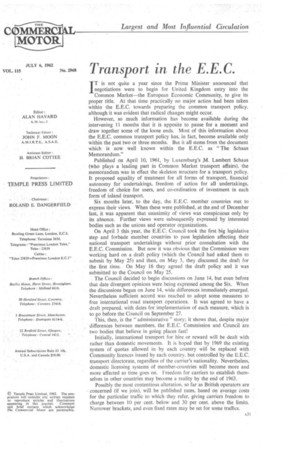Transport in the E.E.C.
Page 33

If you've noticed an error in this article please click here to report it so we can fix it.
IT is not quite a year since the Prime Minister announced that negotiations were to begin for United Kingdom entry into the Common Market—the European Economic Community, to give its proper title. At that time practically no major action had been taken within the E.E.C. towards preparing the common transport policy, although it was evident that radical changes might occur.
However, so much information has become available during the intervening 11 months that it is apposite to pause for a moment and draw together some of the Loose ends. Most of this information about the E.E.C. common transport policy has, in fact, become available only within the past two or three months. But it all stems from the document which• is now well• known within the E.E.C. as "The Schaus Memorandum."
Published on April 10, 1961, by Luxemburg's ,M. Lambert Schaus (who plays a leading part in Common Market transport affairs), the memorandum was in effect the skeleton structure for a transport policy. It proposed equality of treatment for all forms of transport, financial autonomy for undertakings, freedom of action for all undertakings, freedom of choice for users, and co-ordination of investment in each form of inland transport.
Six months later, to the day, the E.E.C. member countries met to express their views. When these were published, at thend of December last, it was apparent that unanimity of views was conspicuous only by its absence. Further views were subsequently expressed by interested bodies such as the unions and operator organizations.
On April 3 this year, the E.E.C. Council took the first big legislative step and forbade member countries to pass legislation affecting their national transport undertakings without prior consultation with the E.E.C. Commission. But now it was obvious that the Commission were working hard on a draft policy (which the Council had asked them to submit by May 25) and then, on May 3, they discussed the draft for the first time. On May 16 they agreed the draft policy and it was submitted to the Council on May 25.
The Council decided to begin discussions on June 14, but even before that date divergent opinions were being expressed among the Six. When the discussions began on June 14, wide differences immediately emerged. Nevertheless sufficient accord was reached to adopt some measures to free international road transport operations. It was agreed to have a draft prepared, with dates for implementation of each measure, which is to go before the Council on September 27.
This then, is the " administrative " story; it shows that despite major differences between members, the E.E.C. Commission and Council are two bodies that believe in going places fast!
Initially, international transport for hire or reward will be dealt with rather than domestic movements. It is hoped that by 1969 the existing system of quotas allowed in by each country will be replaced with Community licences issued by each country, but controlled by the E.E.C. transport directorate, regardless of the carrier's nationality. Nevertheless, domestic licensing systems of member-countries will become more and more affected as time goes on. Freedom for carriers to establish themselves in other countries may become a reality by the end of 1963.
Possibly the most contentious alteration, so far as British operators are concerned (if we join), will be published rates, based on average costs for the particular traffic to which they refer, giving carriers freedom to charge between 10 per cent. below and 30 per cent, above the limits. Narrower brackets, and even fixed rates may be set for some traffics.




















































































































